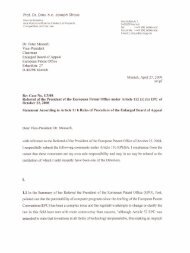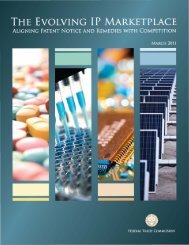Assessing the Obstacles to Industrialisation: The ... - Innovation
Assessing the Obstacles to Industrialisation: The ... - Innovation
Assessing the Obstacles to Industrialisation: The ... - Innovation
Create successful ePaper yourself
Turn your PDF publications into a flip-book with our unique Google optimized e-Paper software.
8 Stephen f-1. f-Jaheravailable on <strong>the</strong> number of workers employed in I 842, but it was probablyin <strong>the</strong> area of ten thousand.13Eleven years later <strong>the</strong> number of active mills had actually declined <strong>to</strong>only 42. O<strong>the</strong>r indica<strong>to</strong>rs suggest, however, that <strong>the</strong> situation hadimproved for <strong>the</strong> remaining mills. If we use raw cot<strong>to</strong>n consumption asa proxy for output (which eliminates <strong>the</strong> problems associated withmeasuring output in goods of different types and different qualities overtime), <strong>the</strong> data indicate a rise in production of I 9 %.'"his increase mayhave been due <strong>to</strong> <strong>the</strong> increase in <strong>the</strong> number of machines in service, whichgrew by 18 O/O. Lack of accurate labour-force data makes it difficult <strong>to</strong>assess <strong>the</strong> growth of labour productivity.By I 877, <strong>the</strong> end of <strong>the</strong> early period of Alexican manufacturing, <strong>the</strong> sizeof <strong>the</strong> cot<strong>to</strong>n-textile industry had increased significantly since <strong>the</strong> I 8 5 0s.Mexico now had 92 cot<strong>to</strong>n mills, though <strong>the</strong>se were somewhat smaller insize than <strong>the</strong> 1854 fac<strong>to</strong>ries: <strong>the</strong> average mill now worked only 2,7j 3spindles with 128 workers, compared <strong>to</strong> 3,004 spindles with 264 workersin 1 8 ~ ~ . ~ ~In comparison <strong>to</strong> <strong>the</strong> United States, this was a modest textile industry.Mexico's zjj,z7o ring spindles in 1877 was an extremely low figurecompared <strong>to</strong> <strong>the</strong> 10.7 million spindles in <strong>the</strong> United States in 1880.16Compared <strong>to</strong> o<strong>the</strong>r Latin American nations, however, this was quite asizeable industry. Brazil, for example, in 1866 possessed but nine mills,employing 768 workers and 14,875 spindles. By 1881 <strong>the</strong> number ofBrazilian mills had increased <strong>to</strong> 44, and now employed 60,419 spindles,but this was still only one-quarter of <strong>the</strong> number in Mexico."Besides cot<strong>to</strong>n textiles o<strong>the</strong>r important industries existed as well,though none functioned on as large a scale. Unfortunately, little in <strong>the</strong> wayl3 Secretaria de Hacienda y Credi<strong>to</strong> Pliblico, Documen<strong>to</strong>s para el estudio de la industriali~acidnen Me'xico, 1837-1841 (Mexico, 1977), doc. 5 ; Minister<strong>to</strong> de Fomen<strong>to</strong>, Estadistica delDepartamen<strong>to</strong> de Mixico (Mexico, 18j4), doc. 2. For a discussion of <strong>the</strong> Banco de Aviosee Robert A. Potash, <strong>The</strong> Mexrcan Government and Industria/ Development in <strong>the</strong> EarlyRepublic: <strong>The</strong> Banco de Az*io (Amherst, 1983). <strong>The</strong> literature has tended <strong>to</strong> overestimate<strong>the</strong> role of <strong>the</strong> bank in financing illexico's early industrialisatlon. <strong>The</strong> <strong>to</strong>tal loans of <strong>the</strong>bank <strong>to</strong> cot<strong>to</strong>n textile manufacturers from 1830 <strong>to</strong> 1842 came <strong>to</strong> yo9,ooo pesos, but inI 8 54, when <strong>the</strong>re were fewer mills in operation than in I 842, <strong>the</strong> <strong>to</strong>tal value of <strong>the</strong> plant,equipment, and buildings of <strong>the</strong> industry (valued at acquisition cost) xvas 8,872,95 Ipesos, indicating that <strong>the</strong> bank could onl!- have been responstble for six per cent of <strong>the</strong>tinance capital of <strong>the</strong>se enterprtses.'' hfinisterio de Fomen<strong>to</strong>, Estadhtica del Departamen<strong>to</strong> de Alixico, doc. 2. '' Calculated from ijid.; and Secretaria de Hacienda, Estadljtica de la RepliDlica ,\lexicana (Mexico, 1880), cuadros de industria.l6 US Bureau of <strong>the</strong> Census, Census oJ~Tlanqactures, 1879." A. 1'. de Borja Castro, 'Rela<strong>to</strong>rio do segundo grupo', in An<strong>to</strong>nio Jose de Souza Rego,Rela<strong>to</strong>rio da segunda exposipio nacionaide 1866 (Rio de Janeiro, I 869), p. 49; hfin~sterio deTrabalho, Industria, e Comercio, Comisio Executiva Textil, ~nd&tria textri algoderra(Rlo de Janeiro, 1946), p. 5 I.





